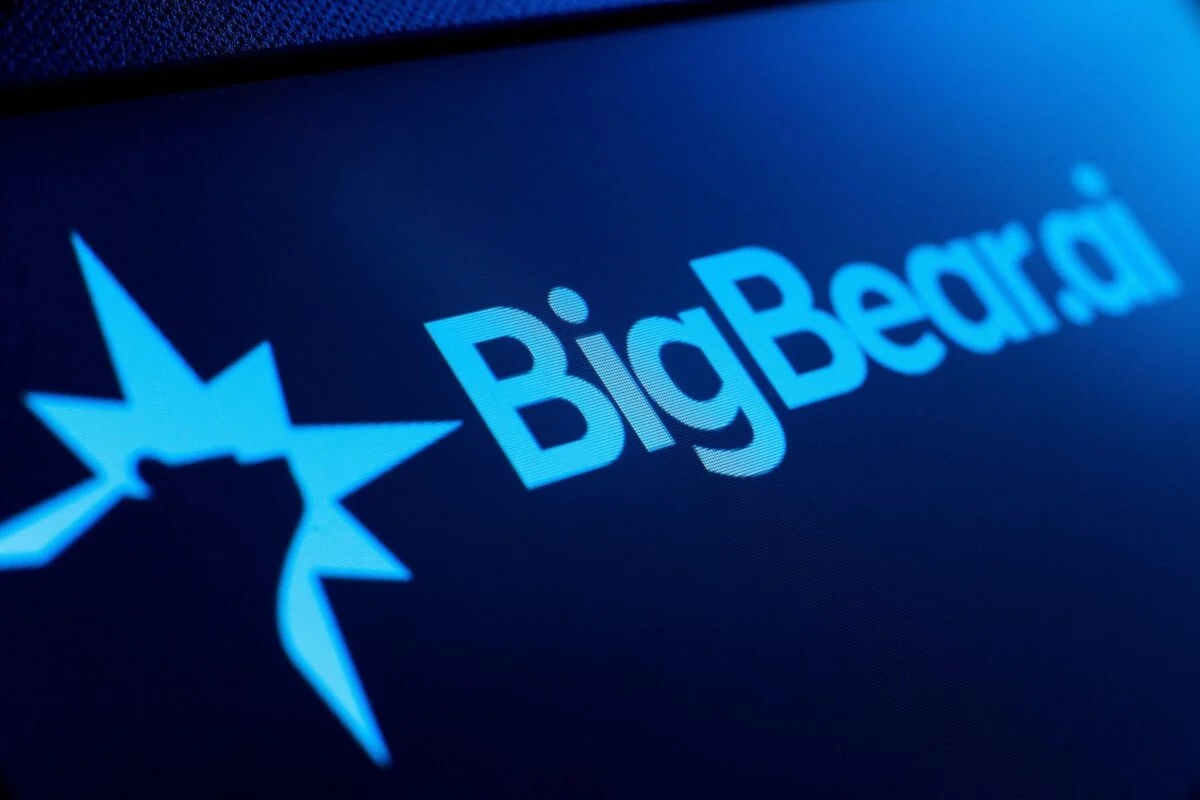TLDR
- BigBear.ai stock closed at $7.05 on October 24, up about 4%, and traded around $7.11 in after-hours on October 25, with year-to-date gains of roughly 80-100%.
- The company announced a strategic AI edge computing partnership with Tsecond on October 13, combining ConductorOS software with BRYCK hardware for battlefield operations, causing a 22% stock jump.
- BigBear.ai deployed its veriScan biometric platform at Chicago O’Hare Airport on October 23, reducing international arrival processing times from 60 seconds to 10 seconds per traveler.
- Q2 2025 revenue dropped 18% year-over-year to $32.5 million with a $228.6 million net loss, leading management to cut full-year revenue guidance from $155 million to $125-140 million.
- Wall Street analysts remain divided with a consensus “Hold” rating and average price target of $6.00, though the company maintains $390 million in cash and a $380 million contract backlog.
BigBear.ai shares have taken off in 2025. The stock closed at $7.05 on October 24, marking about an 80-100% gain year-to-date.
After-hours trading on October 25 saw the stock hovering around $7.11. Trading volume has exploded with recent news, hitting nearly 293 million shares on October 24 alone—a 216% jump from normal levels.
BigBear.ai Holdings, Inc., BBAI
The company’s focus on government and military AI applications has made it a standout performer this year. Some market watchers call it a “mini-Palantir,” comparing it to the defense analytics giant that has surged roughly 300% in 2025.
BigBear.ai operates in a sweet spot right now. Defense budgets are tilting toward AI-driven systems, autonomous drones, and advanced analytics—all areas where the company plays.
Partnership News Fuels October Rally
The recent surge started with an October 13 announcement. BigBear.ai partnered with Tsecond, a Silicon Valley startup, to create a battlefield AI solution.
The deal combines BigBear’s ConductorOS software with Tsecond’s ruggedized BRYCK hardware. This lets military teams process sensor data in seconds, even without cloud connectivity.
CEO Kevin McAleenan emphasized the tactical advantage. “Edge AI must be fast, secure, and simple to deploy under pressure,” he said, noting it helps soldiers “detect threats sooner.”
The stock jumped 22% on the news, briefly touching $9.39 on October 14. It’s since settled back but remains well above pre-announcement levels.
BigBear.ai also scored wins in civilian infrastructure. On September 11, the company rolled out its veriScan biometric system at Nashville International Airport.
The October 23 expansion to Chicago O’Hare brought more attention. The facial recognition platform cuts international arrival processing from 60 seconds down to just 10 seconds per traveler.
U.S. Customs and Border Protection data backs up these claims. The Enhanced Passenger Processing program shows these time savings at airports nationwide.
McAleenan called the O’Hare deployment “a major advancement in securing and accelerating international arrivals.” The Chicago Department of Aviation collaborated on the project.
Beyond these headline deals, BigBear.ai has been busy. The company worked with SMX Solutions on U.S. Navy maritime surveillance during the UNITAS 2025 exercise.
Financial Reality Check
The numbers tell a different story than the stock chart. Q2 2025 revenue came in at $32.5 million, down 18% year-over-year.
That missed analyst expectations by a mile. The consensus forecast was around $41 million.
The company posted a net loss of $228.6 million for the quarter. Most of that came from one-time non-cash charges, but the red ink is still eye-catching.
Management slashed full-year 2025 revenue guidance. The new range of $125-140 million is down from the previous $155 million target.
BigBear.ai withdrew its profit estimates entirely. Analysts say this reflects caution about federal spending uncertainties.
The company does have some financial cushion. It ended Q2 with roughly $390 million in cash—over $2 per share.
The contract backlog sits at $380 million. That suggests future revenue should materialize as projects ramp up, but the timing remains unclear.
Q3 earnings are scheduled for November 10. Investors will be watching closely to see if bookings and sales show improvement.
The company’s net margin was negative 269% in the latest quarter. Revenue is declining while losses mount, creating operational challenges.
Wall Street remains split on BigBear.ai. The consensus rating is “Hold” with an average price target around $6.00.
H.C. Wainwright stands out as bullish. The firm maintains a Buy rating with an $8 price target, citing the strengthened balance sheet and expected defense spending increases.
Some analysts are downright bearish. Weiss Ratings gives the stock a “Sell (D-)” grade, flagging the speculative nature of the investment.
The valuation looks stretched by traditional metrics. BigBear.ai trades at about 13 times projected 2025 sales.
That’s a hefty multiple for a company with declining revenue and no profits. The stock price reflects optimism about future contracts, not current earnings.
Social media discussions mirror the analyst divide. Many traders celebrated the Tsecond deal as bullish, while others pointed to the lowered guidance and ongoing losses.
Some technical analysts see more upside. StockInvest’s AI analysis projects a potential 19% gain over three months based on momentum indicators.
A short-term “pivot bottom” on October 22 launched the current rally. Volume patterns are confirming the upward move, at least for now.
BigBear.ai’s success depends on converting its contract backlog into steady revenue. The company has hinted that several larger awards are in the pipeline.
Government programs often face procurement delays or budget cuts. Any setback in BBAI’s projects could hurt the stock.
High insider selling adds to concerns. The CFO sold shares in late August, raising questions about management’s confidence.
The company competes in an increasingly crowded space. Established players like Palantir and newcomers like Anduril are all chasing the same Pentagon dollars.
BigBear.ai reported $32.5 million in quarterly revenue compared to Palantir’s billions. That gap underscores the difference between the two companies, despite the “mini-Palantir” comparisons.





